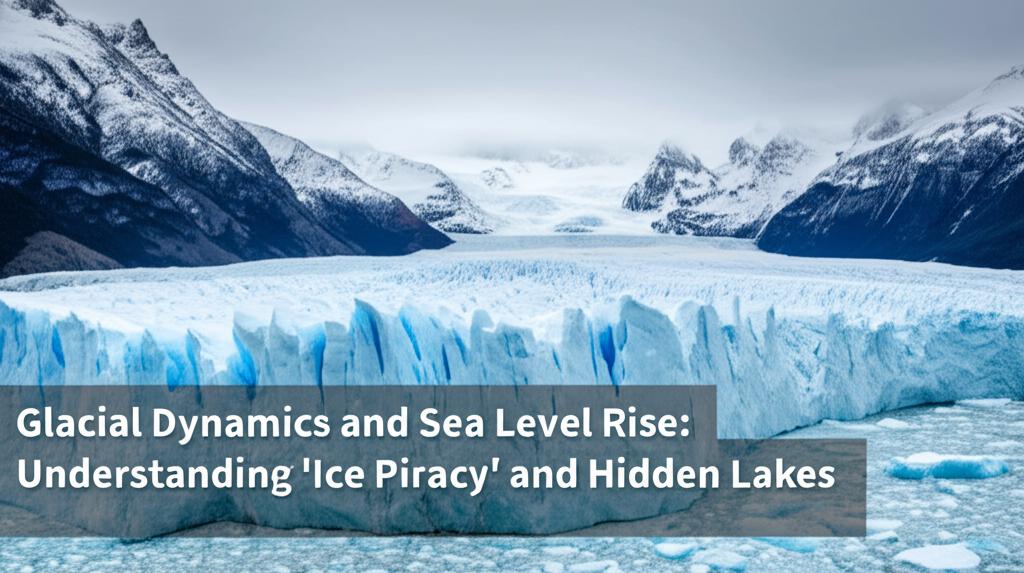The dynamics of glaciers are complex and have a significant impact on global sea levels. Recent discoveries have highlighted two fascinating and concerning phenomena: "ice piracy" and the influence of hidden subglacial lakes.
Ice Piracy: A Rapidly Changing LandscapeA groundbreaking discovery in West Antarctica has revealed a phenomenon dubbed "ice piracy," where one glacier actively "steals" ice from an adjacent, slower-moving glacier. Scientists monitoring the Pope, Smith, and Kohler (PSK) region using high-resolution satellite imagery, including data from Copernicus Sentinel-1 and CryoSat, observed that the Kohler East Glacier has been rapidly siphoning ice from the Kohler West Glacier.
This process, previously thought to take hundreds or even thousands of years, has been observed to occur in less than 18 years. Between 2005 and 2022, researchers noted significant changes in the ice flow of eight streams in the PSK region. Seven of these streams accelerated, with one nearly doubling its speed at the grounding line (where the glacier meets the ocean). In contrast, Kohler West slowed by 10%. The Kohler East and Smith West glaciers saw the most dramatic speed increases, averaging an additional 32 meters per year over the 17-year study period. Overall, glaciers in this region sped up by an average of 51% since 2005.
This rapid redirection of ice flow is attributed to vastly different thinning rates on the neighboring glaciers. As Kohler East flows and thins more quickly, its changing surface slope allows it to draw ice away from the slower Kohler West. This "ice piracy" is a newly recognized process in contemporary ice-sheet dynamics. It underscores the rapid response of glaciers to changing conditions, likely driven by climate change, and has significant implications for understanding future sea-level rise. The accelerated flow and thinning make the "pirating" glacier more likely to draw from its neighbors.
The ice from these glaciers eventually flows into the Dotson and Crosson Ice Shelves, which float on the Amundsen Sea. The rate at which this ice flows and melts directly impacts sea levels. Current data indicates that global sea levels have already risen by more than 10 centimeters (approximately 4 inches) in the last decade, and projections suggest over 410 million people could be at risk from rising sea levels by 2100.
Hidden Subglacial Lakes: Destabilizing Forces Beneath the IceBeneath the vast ice sheets of Antarctica lie hidden subglacial lakes – large bodies of freshwater concealed deep below the ice surface. These lakes, once thought to be relatively static features, are now understood to play a dynamic role in glacier stability and ice loss.
Research, particularly on the Thwaites Glacier (nicknamed the "Doomsday Glacier" due to its potential to significantly raise sea levels if it collapses), has shed new light on this. In 2013, a dramatic event occurred when seven subglacial lakes beneath Thwaites Glacier simultaneously drained, releasing approximately seven cubic kilometers of freshwater into the Amundsen Sea – a volume comparable to Loch Ness.
This sudden drainage had significant consequences. Using satellite altimetry data from missions like ESA's CryoSat, scientists observed that such events create plumes of cold freshwater that rise and mix with warmer, deep ocean water. This upwelling of warm water intensifies melting at the base of the floating ice shelf, a process known as basal melting. Following the 2013 drainage, melt rates at the Thwaites ice shelves temporarily doubled, leading to significant ice thinning.
Increased basal melting can cause the grounding line of a glacier to retreat further inland. This makes the glacier less stable and can accelerate its flow towards the ocean. The Thwaites Glacier region is particularly vulnerable due to the shape of the bedrock beneath it, which deepens inland, creating a scenario where initial melting can lead to progressively faster ice loss.
Interestingly, while large, abrupt drainage events cause sudden spikes in melting, a steady, continuous flow of water from subglacial lakes might, in the long run, produce even more melting by keeping the conditions under the ice shelf consistently primed for it.
These findings highlight the critical need to incorporate subglacial hydrology into models used to predict future ice loss and sea-level rise. Oversimplifying or omitting these drainage processes could lead to an underestimation of the melt rate of vulnerable glaciers like Thwaites. As global temperatures rise, an increase in surface melt is expected, which could lead to more subglacial water and potentially more frequent drainage events, further destabilizing glaciers.
Broader Implications for Glacial Dynamics and Sea Level RiseBeyond "ice piracy" and subglacial lake drainage, other factors influence glacial dynamics. For instance, studies on the Greenland Ice Sheet have revealed a significant increase in surface crevasses (wedge-shaped fractures in the ice) in key regions. These crevasses can accelerate ice loss by channeling meltwater to the glacier bed, which lubricates the base and encourages faster flow, and by enhancing the calving of icebergs into the ocean. Between 2016 and 2021, crevasse volume in marine-terminating sectors of Greenland, where glaciers flow directly into the ocean, increased by up to 25%.
The massive Greenland and Antarctic ice sheets hold enough ice to raise global sea levels by approximately 65 meters. While some recent research offers a slightly more optimistic outlook on the worst-case scenarios for the Thwaites Glacier this century, suggesting a catastrophic collapse driven by "marine ice cliff instability" (MICI) is less likely than previously feared, the overall loss of polar ice remains a significant and pressing threat. Glaciers worldwide are currently losing an average of 273 billion tonnes of ice per year, a rate that has accelerated in the past decade, making them the second-largest contributor to global sea-level rise after the thermal expansion of oceans.
Understanding these complex and interconnected processes – from the rapid "theft" of ice by one glacier from another to the destabilizing influence of hidden lakes and the growing network of crevasses – is crucial for accurately predicting future sea-level rise and developing effective climate adaptation strategies. Satellite observations continue to be invaluable in monitoring these remote and rapidly changing environments.

